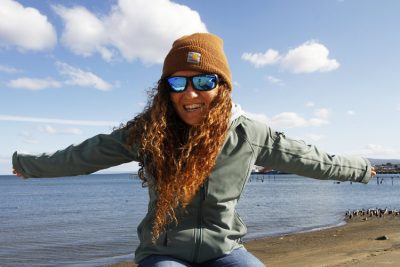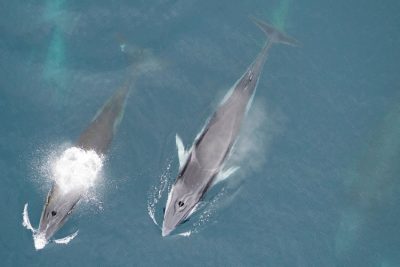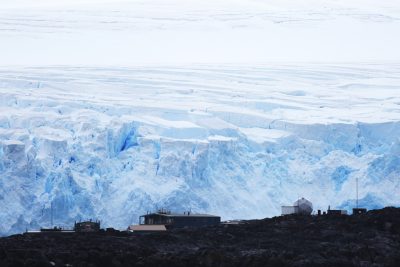
One doesn’t hear many people say they wish they’d been on a ship stuck in ice for four days in the middle of Antarctica’s treacherous Weddell Sea.
It is, after all, a harrowing, cold place. The place where the three-masted ship, The Endurance, sailed by Sir Ernest Shackleton, was famously crushed by ice and sunk by flooding in 1915. It took months to rescue the folks that were on the ship.
Supporter Spotlight
But when Dr. Andy Read, a marine mammal expert and director of the Duke University Marine Laboratory in Beaufort, said recently he wished he was stuck there, he was dead serious. He was truly jealous of his colleagues from the National Oceanic and Atmospheric Administration, Duke, Stanford University and the University of California-Santa Cruz.
“I’d trade,” he said, even though Duke was playing its opening-round NCAA basketball tournament game against Iona in a few hours. “I wish I was there.”
His colleagues, he said, were having all the fun while he was stuck in Beaufort with his administrative duties – not that he minds them, mind you – and doing research that’s generally much more mundane than chasing and tagging minke whales in Antarctica.
Fun? Fun? Really? This is how Mary Lide Parker, a freelance journalist on the polar trip, put it in her online blog, “The Pago Files,” which has been appearing through a link to the researchers’ postings on Twitter. A pagophile is any living organism that thrives in ice. Pago is a word of Greek origin, meaning cold, frost, freezing; fixed or hardened.
“KC is staring out the porthole window in the gym when I pose an annoying question.
Supporter Spotlight
“‘Wanna hear something depressing?’”
“He turns away from the window and removes his earbuds. ‘What’s that?’
“I point to the mileage number on the treadmill where I’m currently walking. ‘I’ve gone farther on this treadmill in the past 30 minutes than the ship has gone in the past 30 hours.’”
“He laughs, and I laugh with him. We have to laugh so we don’t go insane.”

Parker is along because the National Science Foundation, or NSF, which funded the research trip, now generally requires researchers to have someone well-qualified along to document their research, according to Read.
She’s had plenty to write about and photograph.
On the fifth day, Read said, the vessel, the 230-foot-long RV Laurence M. Gould, got out of the ice, and the scientists should be back in the United States by about the end of the month, ending a seven-week expedition that he said included 12 days of actual research time around the Antarctic Peninsula.
That’s a tale of how long it takes to get to Antarctica, prepare, do your stuff and get back. It’s a loooooong way. And it’s not smooth sailing. It’s among the roughest, toughest passages in the world.
Folks on board from North Carolina include Dr. David Johnston, associate professor of the Practice of Marine Conservation & Ecology at Duke University and director of the Duke Marine Robotics and Remote Sensing Lab, and Dr. Chris Taylor, a research ecologist with NOAA’s National Centers for Coastal Ocean Science lab in Beaufort.
Taylor is an expert in using underwater acoustics – fisheries sonar, fish-finding echo sunders and multi-beam sonar. On this trip he has also measured krill from a net towed through whale feeding hot spots and has quantified krill density and distribution using echo-sounders. Krill is what baleen whales eat, they’re tiny crustaceans, kind of like mini-shrimp.
You might not think it would be hard to find a whale. Minke whales are so-called “small,” by baleen whale standards, but that’s a relative term. Adults generally are 23 to 26 feet long and weigh 4 to 5 tons. That’s 8,000 to 10,000 pounds, at least twice the weight of an average motor vehicle in the U.S., since we drive such big stuff. It’s a BIG critter.
But minkes, Read said, are very fast, much faster than the larger humpbacks that frequent the Antarctic. They can, according to internet sources, swim at 21 mph when they feel threatened. The fastest human, officially, is Usain Bolt, who hit 27.8 mph during the 100-meter sprint in the 2009 world track championships. He obviously didn’t weight 4 or 5 tons and wasn’t pushing against water.
First, if you want to study a minke, you’ve got to catch up with one. And of course there’s the ice thing. They spend a lot of time under it, hiding from their main predator, the killer whale. You have to be at the right place at the right time in order to see what they do.
So why spend several weeks traveling to and returning from one of the most isolated places in the world to study whales that are fast, often under ice and, according to Read, “shy?”

“Relatively little has been known about minke whales,” Read said. “One thing we want to know is how they and the humpbacks co-exist.”
Both species, for example, eat mostly krill, those small crustaceans found in all the world’s oceans. Krill feed on phytoplankton and zooplankton, converting these into a form suitable for many larger animals.
In the Southern Ocean, one species, the Antarctic krill, makes up an estimated biomass of around 3.79 million tons. But how much do these whales eat? Do they compete for food? Do the two species, the humpbacks and the minkes, get along?
“Basically, what we want to know is, ‘How does the minke make its living down there?’” Read said.
The minkes, he said, have established a good niche in the Antarctic, in part because of their small relative size. They can maneuver well between ice patches, and they eat smaller portions, which lets them survive around less dense patches of krill.
There’s no doubt, he said, that they do quite well. They’re not threatened or endangered, in fact they are “very abundant.”
Another thing the researchers want to know is how the minke and other species of whales are being affected by climate change.
“The peninsula is warming very fast,” Read said. “We’re actually beginning to see grass take hold in some places. And we’re seeing more (warmer weather) species of penguins.”
As ice thins or breaks up, will the minke whales have less ability to hide from predators? Will their population continue to grow or will it shrink? And what impacts will either have on the humpback?
The technology the researchers are using to investigate these questions and others didn’t really even exist just a few years ago.

Drones, Johnston’s specialty on this trip, can not only photograph the minke whales, they also enable the researchers to measure them, both length, which can indicate age, and how fat they are: an indicator of health. You don’t want to see skinny whales.
But as important as the drones are to the research, the “stars of the show,” Read said, are two different kind of tags.
Some stay on for long periods of time and upload data to weather satellites. These allow researchers to follow minkes for extended periods to learn where they go and when, but there’s a lot of competition for data use on those satellites.
Other tags used more are short-term, for about 24 hours or less, and are attached with suction cups. Until recently, no one’s been very successful putting the tags on minke whales.
“These are like iPhones on steroids,” Read said of these tags. “You can hear all the sounds the whales make and the sounds they hear, and you can see what they see, see what their habitat looks like. It’s really amazing.”
The problem is, these tags are very expensive. Just one costs about $25,000. So, Read said, “You have get them back when they fall off. They’re supposed to float to the surface,” and you find them because they send out a radio beacon. Usually.
The big problem, Read said, is that sometimes they fall off under the ice. At $25,000 a tag, you don’t want that to happen. Luckily, Read said, the team on this trip hadn’t lost one as of March 15, the day of this interview.
In fact, he said, all of the work has gone exceptionally well. The team has seen and tagged lots of minkes. On one day, according to one of Parker’s Twitter posts, the team had completed six drone flights over 11 whales by lunch time.
All of this research has been based from the Gould, which according to the NSF website, can accommodate up to 26 scientists and associated staff, and consistently shuttles people and supplies between Punta Arenas, Chile and Palmer Station, Antarctica.
Read said it’s pretty comfortable for those accustomed to such missions, and generally has little problem getting through the ice. But on this trip, it did.
Early in the trip, the Gould had dropped a team of geologists on Joinville Island, which Parker in her blog called a “barren, windswept strip of land.” On the way back to pick the geologists up, things came to virtual halt.
“Right now we’re about nine miles away, the mountains of the island just barely visible through a layer of low-lying clouds,” Parker wrote in her blog. “Nine miles doesn’t seem that far, until Dave Johnston tells me we have covered just over mile in the past five hours.
“‘Pray for a change in winds,’” she said Johnston said, “‘Otherwise we’re going to be here for a while.’”
They were.
“Every so often we hear harsh grinding noises emanating from the metal hull of the ship, usually followed by a sudden, awkward lean,” Parker wrote.
“All afternoon the ship rams forward, then jerks into reverse. In the evening, just before the sun begins to set, a thick fog descends. The ship finally stops moving, and I head to the bow with my camera.
“There is no other word for it — we are in a void.”

By day four,” she added later in the dispatch, “it is apparent to everyone that we aren’t going to make it to Joinville Island. Fortunately, at the bottom of the world, the immense forces of nature are matched by human generosity, often in the form of a helping hand from complete strangers.
The Argentinian Navy, Read said, sent two helicopters to evacuate the geology team from the island, and then took them to an Argentinian vessel. Eventually, when the Gould got “unstuck,” the ships rendezvoused. Everyone was fine despite the ordeal. Folks might have been bored, he said, but there were plenty of provisions, and no real danger.
Still, Read echoed Parker’s comment about “human generosity, often in the form of a helping hand from complete strangers.” In such an unforgiving and remote place, he said, “It’s how you survive at times.”
Read is looking forward to using some of the technologies used in Antarctica in Carteret County this year.
Whales are increasingly common in the waters off the county, he said, perhaps partly because changing climate. Folks are seeing more juvenile humpbacks in the winter and spring, mostly juveniles, most likely feeding on menhaden and croaker.
“If we could do some of this here, it would be cool,” he said.








